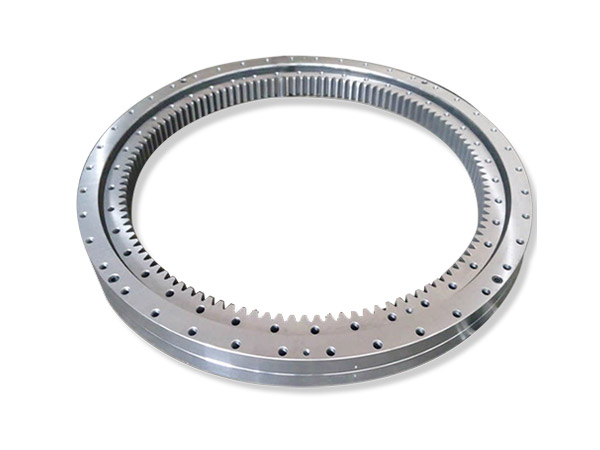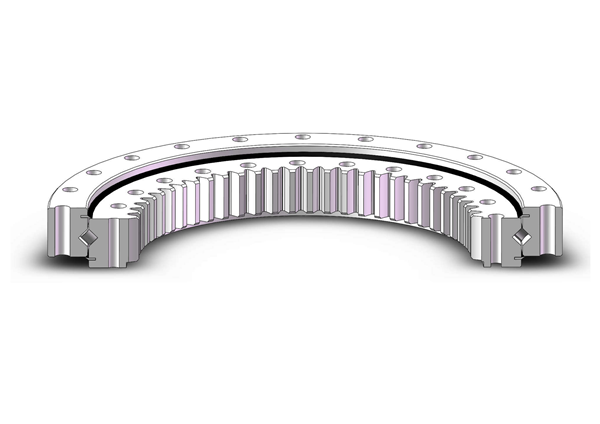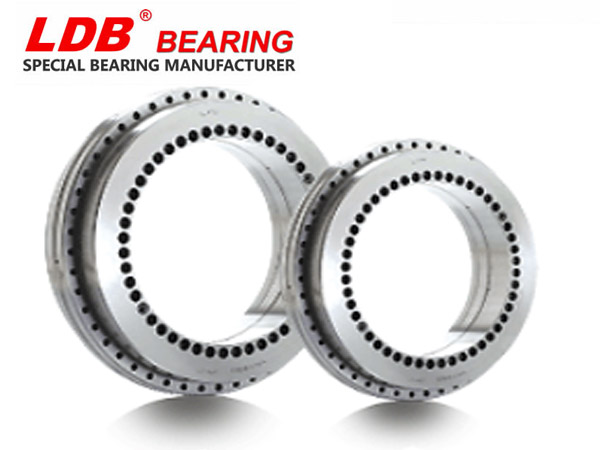Four forms and maintenance skills of slewing bearing raceway failure
The failure of the bearing raceway will directly lead to the overall failure of the slewing bearing. The life of the slewing bearing raceway is affected by its own quality and later maintenance. Therefore, the daily maintenance of the slewing bearing raceway is very important.
When we find that the raceway fails, there are mostly five manifestations: large bearing clearance, oil leakage from the bearing, stuck running of the bearing, abnormal noise from the bearing, iron powder or iron lumps in the slewing bearing raceway. The four forms of track failure will be briefly introduced to you, and at the same time, I will share with you some daily maintenance skills for the slewing bearing raceway.
Four forms of slewing bearing raceway failure

1. Surface peeling
The main reason for the surface peeling of the slewing bearing raceway is that the hardened layer is too thin and the hardness transition zone is too narrow. There are many reasons for contact fatigue failure, which may be excessive axial load, poor lubrication, poor alignment, excessive impact load during installation, etc., which can cause contact fatigue failure of bearings. Intermediate frequency equipment with lower frequencies should be used to deepen the hardened layer. At the same time, the quenched and tempered hardness should be appropriately increased to reduce the hardness gradient of the raceway section.
2. Corrosion pitting
The chemical or electrochemical reaction occurs between the metal surface and the environmental medium, and the surface damage caused by it is called corrosion failure. Corrosion is divided into three categories: chemical corrosion, electrical corrosion, and fretting corrosion, mainly manifested as the corrosion of the inner bearing surface of the bearing. The intrusion of corrosive medium, condensation of moisture in the air, sparks generated when the current passes, fretting and other factors can cause the corrosion failure of the slewing bearing raceway.
Pitting corrosion mainly occurs on the raceway treated with quenching and tempering. The reasons are low hardness and unreasonable design of raceway structure, causing sliding friction and contact fatigue stress, resulting in defects such as pitting and indentation.
3. Plastic deformation
Under the action of external force, the local plastic flow or overall deformation of the surface of the part, such as the deformation of the raceway or the distortion and warpage of the cage, etc., cause the failure of the slewing bearing to not work properly, which is called plastic deformation failure. This situation often occurs after a period of use. At this time, most of the high-hardness layer has been worn, and after the load and friction force suddenly increase, the metal inside and outside the raceway is squeezed into piles. Steel grades with high hardenability should be used instead.
4. Wear
The relative sliding friction between the surfaces leads to the continuous wear and tear of the metal on the working surface, resulting in failure. Wear will increase the fit clearance and change the shape of the raceway surface, and also affect the lubricating function of the lubricant, causing the bearing to lose its rotational accuracy or even fail to operate normally. Raceway wear is divided into normal wear and abnormal wear.
Normal wear and tear is the process of gradually increasing the gap in the whole life cycle to complete the task of the whole life cycle. Abnormal wear has manufacturing problems, standard parts problems, grease problems and post-maintenance problems.
The post-maintenance skills of the slewing bearing raceway

1. Slewing bearing raceway lubrication
(1) Selection of grease: For the slewing bearing, grease is equivalent to the relationship between fish and water. If the best quality product does not pay attention to the lubrication of the raceway, it is the state when the fish leaves.
The general grease used for slewing bearings used in general construction machinery is usually 2# or 3# lithium-based grease. It is recommended to use lithium molybdenum disulfide grease for heavy-duty products, and low-temperature lubricating grease is used in severe cold areas. Grease, in high temperature environment is high temperature grease, the grease used in wind power slewing bearing is usually NLGI1.5 to 2 grade lithium-based, complex lithium-based, calcium grease, the choice of different environmental greases are differentiated .
(2) Grease filling frequency: In dry and clean occasions, it is recommended to refill once every 500 hours of operation, and once every 250 hours of operation for construction machinery in outdoor environments, and once every 50 to 100 hours of operation in harsh environments. In some closed dust environments, continuous filling is recommended.
Some equipment is going to be stopped for a long time. It is recommended to fill up the grease when stopping the operation, and squeeze out the old grease. When re-operating, it is recommended to refill the grease again. At this time, only a small amount of lithium base grease is needed to be replenished. Newly purchased equipment is recommended to be filled with grease.
(3) Grease filling method: one is manual filling, and the other is automatic filling equipment on the equipment, which adopts automatic filling.
2. Maintenance of slewing bearing sealing ring
The sealing ring is the first wall of the slewing bearing, which can be used to prevent foreign objects such as sand outside the slewing bearing from entering the raceway, causing wear of the rolling elements and the raceway. If the sealing ring is damaged, the problem is the leakage of grease. And dust and dirt enter the raceway, resulting in the rapid wear and failure of the raceway.
In terms of the maintenance of the sealing ring, firstly, after the main engine is working in acid and alkali occasions, it should be cleaned in time; secondly, check whether the lower sealing ring is damaged or fall off each time oil is injected; thirdly, check whether the sealing ring is worn at least once every three months. Seriously, whether there is an oil leak.
If there are any of the above three phenomena, it is recommended to replace the sealing ring immediately. It is not recommended to replace the sealing ring personally. You should ask a technician to replace it, so as to ensure the service life of the sealing ring.
The failure manifestations and causes of the slewing bearing raceway have been introduced in detail above. We do a good job in the daily maintenance of the slewing bearing raceway in daily use, which can also prolong the service life of the bearing.



